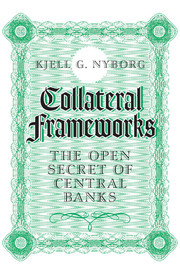Book contents
- Frontmatter
- Contents
- List of Figures
- List of Tables
- List of Exhibits
- List of Examples
- Preface
- Acknowledgments
- 1 Background and Motivation
- 2 Collateral Frameworks: Overview
- 3 Monetary Policy Implementation in the Euro Area over Time
- 4 Evidence on the Production and Usage of Collateral
- 5 Haircuts
- 6 Ratings and Guarantees
- 7 Market and Theoretical Prices
- 8 Collateral “Own Use”
- 9 Non-regulated Markets, Unsecured Bank Debt, and LTRO Uptake
- 10 Market Discipline
- 11 Bailing Out the Euro
- 12 The Endgame of the Euro Crisis
- 13 Restoring Credibility
- 14 The Problem with Collateral
- 15 Concluding Remarks
- Appendix: Haircut and Rating Rules Updates
- References
- Index
1 - Background and Motivation
Published online by Cambridge University Press: 06 January 2017
- Frontmatter
- Contents
- List of Figures
- List of Tables
- List of Exhibits
- List of Examples
- Preface
- Acknowledgments
- 1 Background and Motivation
- 2 Collateral Frameworks: Overview
- 3 Monetary Policy Implementation in the Euro Area over Time
- 4 Evidence on the Production and Usage of Collateral
- 5 Haircuts
- 6 Ratings and Guarantees
- 7 Market and Theoretical Prices
- 8 Collateral “Own Use”
- 9 Non-regulated Markets, Unsecured Bank Debt, and LTRO Uptake
- 10 Market Discipline
- 11 Bailing Out the Euro
- 12 The Endgame of the Euro Crisis
- 13 Restoring Credibility
- 14 The Problem with Collateral
- 15 Concluding Remarks
- Appendix: Haircut and Rating Rules Updates
- References
- Index
Summary
It is commonly accepted that monetary policy affects the wider economy. There is also emerging evidence that there are monetary effects in financial markets. However, most work on these topics looks at broad-brush policy variables such as short-term interest rates or the quantity of money. There is a dearth of work on monetary economics or finance and banking that studies the micro-foundation of the monetary system and its impact on markets and the economy. The broad objective of this book is to contribute toward filling that gap. This is important in light of the ongoing challenges in the global economy, where central banks are engaged in quantitative easing and other forms of unconventional monetary policy in an effort to stabilize and support the economy, banks, and the financial markets. In the euro area, monetary policy is even in the vanguard in the fight to save the euro and European project itself.
Banking and finance are central to the broader economy because money flows through the banking sector and the financial system. A better understanding of how this works requires, in the first instance, a deeper and more detailed knowledge of monetary system architecture. Modern monetary systems are organized around central banks and their money, what bankers call liquidity. Central bank money is injected by central banks into the banking system against collateral on terms defined, not in a market, but by central banks through their collateral frameworks. In some jurisdictions, or currency areas, central bank independence means that collateral frameworks are not subject to formal supervision, review, or even much by way of discussion. Public focus is instead directed toward interest rates or monetary aggregates. This book therefore aims to bring to light the functioning, reach, and impact of collateral frameworks.
Different central banks have different collateral frameworks. There are common features, but details can vary a great deal. The focus in this book is on the framework of the Eurosystem, i.e., the collective structure of national central banks in the euro area spearheaded by the European Central Bank (ECB). The ECB plays a principal role because it is authorized to design and update the euro area's collateral framework.
Information
- Type
- Chapter
- Information
- Collateral FrameworksThe Open Secret of Central Banks, pp. 1 - 17Publisher: Cambridge University PressPrint publication year: 2016
